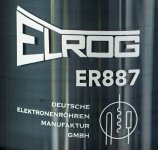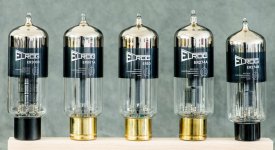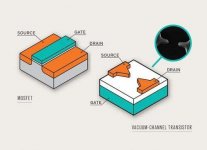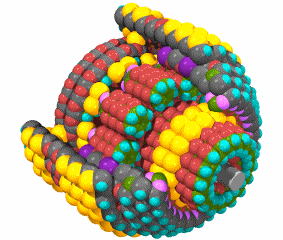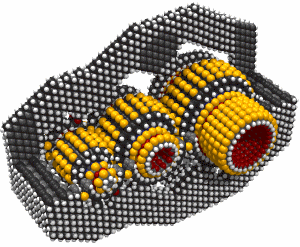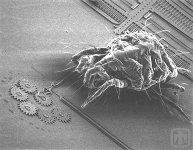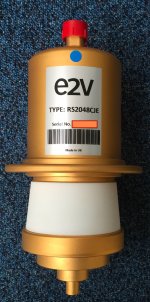for REAL power at high frequency there is no substitute for a vacuumtube.
High power needs high voltage AND high currents.
And what would be better than a tube wich combines the ideals of vacuum and a steam or fluid cooled solid copper anode?
A semi-conductor???
Tubes can handle Ua peak in the tens of kV with hundreds of amps peak at megacycles.
High power needs high voltage AND high currents.
And what would be better than a tube wich combines the ideals of vacuum and a steam or fluid cooled solid copper anode?
A semi-conductor???
Tubes can handle Ua peak in the tens of kV with hundreds of amps peak at megacycles.
The main obstacle to survival of audio tubes is the high price and extremely low useful life of these products, I has informed a average sino 300B lasted only 700 hours driving a 805 (no soft start though).
There are reports WE-300B from 1940s came to last 10K to 40.000 hours and today tube manufacturers that offer 300B with 5 years warranty on the shelf are highly praised...
There are reports WE-300B from 1940s came to last 10K to 40.000 hours and today tube manufacturers that offer 300B with 5 years warranty on the shelf are highly praised...
Last edited:
Attachments
The article was on our intranet, and I can't find it in a google search. I suspect the link I've attached is not reachable, but added it just in case it is.
It seems the last bastion of tubes is high power high frequency RF, and that niche may be closing to SS technology...
This is irrelevant to VTs for audio. I don't think this is going away any time soon. There are still lots of left over TV types from the good ol' days (lots of TVs made, and plenty enough of the VTs they used both for new production and as replacements) and new production for gee-tah amplification. You will probably see the depletion of TV types over the years, but I'm pretty much set so far as that goes. Still, types like the 6L6-oids will be around a lot longer, and can be used for sound reproduction amps with excellent sonic performance.
If there's a "crisis" it's in the solid state arena. Good sounding transistors are becoming as rare as WE 300B's and go for similar prices. VFETs: gone (talk about WE 300B level rarity and cost)! Lateral MOSFETs are a niche item produced by a few boutique manufacturers. These days, the big demand is for switching devices that typically make for poor audio amplification. That drove out the decent SS audio devices.
for REAL power at high frequency there is no substitute for a vacuumtube.
High power needs high voltage AND high currents.
And what would be better than a tube wich combines the ideals of vacuum and a steam or fluid cooled solid copper anode?
A semi-conductor???
Tubes can handle Ua peak in the tens of kV with hundreds of amps peak at megacycles.
BLF888E Transistor LDMOS 750W UHF watercooled for DVB service
BLF888E | UHF power LDMOS transistor | AMPLEON
As with computers the magic word is Parallel
16 on a bord for 2.8kw
10 boards fit in a cabinet for 25kw
6 cabinets can be paralleled for 150kw
So far I know all DVB transmitters in Europe were solid state from the very beginning
Obviously it is economic and reliable despite the fact that a single tube could do the job ...
Example:
http://anywavecom.net/wp-content/up...PTV-Tranmsitters-Product-Brochure-18.03-1.pdf
Last edited:
Tube technology is alive and kicking!
Check out the latest development here:
Nutube – English | korgnutube.com – English
Check out the latest development here:
Nutube – English | korgnutube.com – English
can't explain how a $8 6922 tube can beat an OP275 but it crushes it in sound quality even with the op275's 0.0003% THD figure. 6922 is also rated to exceed 10,000 hours.
It is simply cheaper to use tubes properly. They are not disappearing anytime soon.
I agree. Jet-ink printers exist but we still buy paintings. There is the same step with transistors and tubes in quality.
Maybe transistors in the near future be more like tubes with the vacuum as well 
Vacuum channel transistor combines best of semiconductors and vacuum tubes
Scientists explore mash-up of vacuum tube and MOSFET
The end of classic transistors ?
Vacuum channel transistor combines best of semiconductors and vacuum tubes
Scientists explore mash-up of vacuum tube and MOSFET
The end of classic transistors ?
Attachments
Just to show an example of a modern high power vacuum tube
The RS 3700 CJ is a RF power triode designed specifically for industrial applications. This tube uses a coaxial design and metal-ceramic technology. This triode is designed to operate in CW mode.
Output power: 1250 kW in CW mode
Maximum ratings: Anode voltage: up to 15 MHz 20 kV (from 15 to 30 MHz 16 kV) Control-grid voltage- 2 kV Peak cathode current, CW 650 A Anode dissipation 500 kW Grid dissipation 10 kW
Operating position vertical, anode up or down Weight 80 kg approx Max diameter 350 mm Heigth incl. G1.5" water conn. 860 mm
The RS 3700 CJ is a RF power triode designed specifically for industrial applications. This tube uses a coaxial design and metal-ceramic technology. This triode is designed to operate in CW mode.
Output power: 1250 kW in CW mode
Maximum ratings: Anode voltage: up to 15 MHz 20 kV (from 15 to 30 MHz 16 kV) Control-grid voltage- 2 kV Peak cathode current, CW 650 A Anode dissipation 500 kW Grid dissipation 10 kW
Operating position vertical, anode up or down Weight 80 kg approx Max diameter 350 mm Heigth incl. G1.5" water conn. 860 mm
Based on what I read in this thread it seems like some kind of tube will be around for a long time. Is there an economic problem though with supporting industries for audio tube manufacture? If it is just a matter of QC in a Chinese or Russian factory, it seems like a pretty easy problem to solve but as far as I have read the newer tubes don’t match the older for quality. So, is there something special about older materials like grid wire, cathode material or sheet stock for plates that just can’t be had today without a super expensive custom run? Or…. Is the whole older tubes are better thing a myth?
Member
Joined 2009
Paid Member
Just to show an example of a modern high power vacuum tube
The RS 3700 CJ is a RF power triode
I collect valves here and there as the opportunity arrises and have the one shown attached, a tetrode not a triode. As it needs a 100 Amp heater I don't expect to be using it soon.
Attachments
Last edited:
I collect valves here and there as the opportunity arrises and have the one shown attached, a tetrode not a triode. As it needs a 100 Amp heater I don't expect to be using it soon.
nothing that can't be solved with an old server powersupply
Even if high power RF tube applications go solid state I doubt it will have much if any effect on the manufacture of audio tubes.
If those applications go SS (which I seriously doubt) That will just mean More good old amplifier tubes for me.
An SS kilowatt amplifier is way complicated, while a kilowatt tube amp is quite simple.
- Status
- This old topic is closed. If you want to reopen this topic, contact a moderator using the "Report Post" button.
- Home
- Amplifiers
- Tubes / Valves
- The end of tubes?


